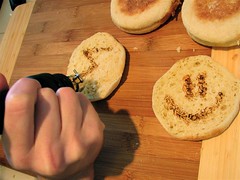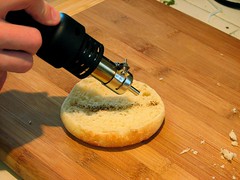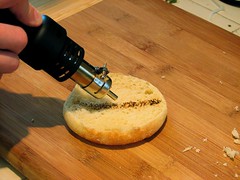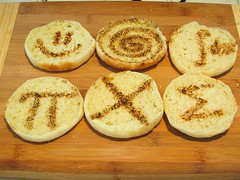It’s a simple formula, really: hot air gun + bread = interesting toast.
All evidence suggests that we are now living in a modern renaissance of the toasting arts– what history will soon recognize as the era when toasting went digital and the human race finally broke free from its ancient bonds of monochrome squares.
Or maybe not. Whatever history will say about it, we have seen a lot of rapid toaster evolution lately. Concept cars have been around since the beginning, but it’s perhaps only in the last year that concept toasters have been getting some attention. (Here are three interesting ones.)
A popular shtick for toaster design has been to have the toaster impress some image or message upon the toast. An example, and one of the interesting early toasters of the modern toast renaissance, is a weather toaster (circa 2001) that indicates the day’s weather forecast with a sun or cloud symbol on the toast. Just in case you don’t want to provide your toaster with an internet connection, there are other types like those made by Pop Art Toasters with manually interchangeable image plates. Pop Art also produces this brilliant toaster set that includes food coloring pens (!) so that you can color in the drawings on your toast. (You could save the pens to customize your hearts as well.)
At the low end of the spectrum of toast-imaging display technology are such gems as the Sanyo Hello Kitty Toaster or the (remarkably similar) Skull and crossbones model. If those aren’t scary enough, you might look at this one, too.
To really be interesting as a display technology, a toaster should be able to produce an infinite variety of graphics, ideally with high resolution. The Zuse is a high-end 12 x 12 dot matrix toast printer which looks wonderfully precise, but is not programmable. One can achieve truly impressive resolution with a laser engraver, but the problem is that it does not so much toast as simply disintegrate the parts where the laser hits, leaving it ambiguous as to whether selective toasting has really occurred. (And before anyone asks, yes, using Sharpies is just plain cheating.)
The most impressive toast art that we have seen is indeed still fully analog, and it may be some time before digital toast imaging technology truly fulfills its promise. On the bright side, it’s quite straightforward to do your own analog toasting, either with cookie cutters and masks (like the previous examples), with an electric hot air gun as we use, or even a fine-point butane or propane torch– if you promise not to burn down the house.
Our heat gun is a hot air rework station, a type of device used for soldering and desoldering electronic components. Ours is an Aoyoe 850A++, which we got for $100 at Stan Rubinstein.
This unit is brand new, lead free, and has never been used on solder of any type. It may be obvious, but you should never use a regular or used soldering iron to cook your food!
This machine is also complete overkill, with regulated and adjustable temperature and adjustable airflow– we really got it for a different purpose. A much more economical choice for toasting might be an embossing heat gun, typically $15-20.
Our blank toast display medium bread choice was a set of Oroweat extra crispy english muffins, our favorites.
Using the hot air gun is pretty straight forward– hold it in one place until the spot that you are pointing at turns sufficiently dark, just a few seconds, and move on to the next spot. These muffins took about one minute each to decorate.
The resolution was better than you might expect given the technique; you can see the resolution limit in the upper-right muffin half, where I attempted to write the integral dx, but you can’t really read the dx. That’s probably okay– not everyone wants calculus with breakfast.
This procedure makes the muffins look and smell great, but it doesn’t really succeed in toasting the majority of the surface; it obviously misses the entire back side. For outstanding results with proper texture and temperature, take the properly decorated muffins from this stage, and very lightly toast them as normal in the toaster, such that you don’t significantly darken any portion in the toaster. QED.













(3D printer – Z axis) + hot air rework station=completly digital toast imaging technology .
How right you are!
—
Windell H. Oskay
drwho(at)evilmadscientist.com
http://www.evilmadscientist.com/
It’s too bad the Pi muffin was created just a couple weeks too late for Pi Day. Well, there’s next year.
There’s also 2 Pi day, 6/28. (That way you can use the whole pie, right?)
—
Windell H. Oskay
drwho(at)evilmadscientist.com
http://www.evilmadscientist.com/